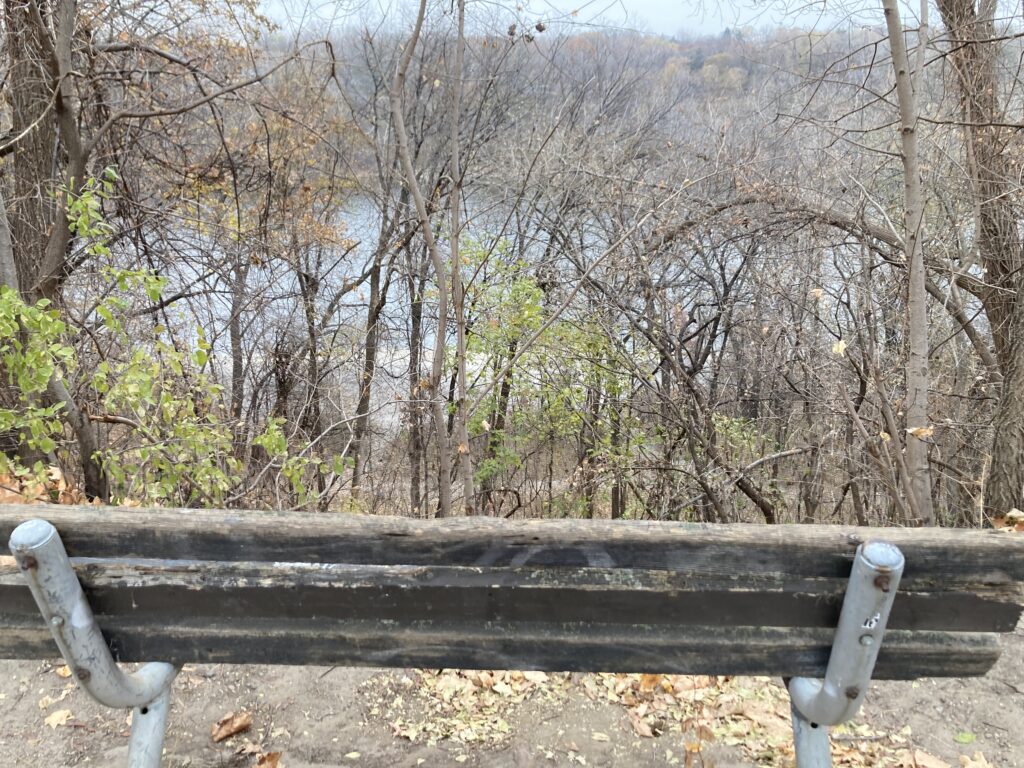3.65 miles
trestle turn around
17 degrees / feels like 2
100% snow and ice covered
It snowed again last night. A dusting. I think we might get a lot of snow this winter. Hooray! I’m ready for winter running! Today, I didn’t like running straight into the wind at the beginning, but it wasn’t too bad and it was at my back on the way home. I liked running with the yaktrax. At first, my feet were sore, but that didn’t last long. There were a few runners, some walkers. No skiers or bikers.
Geese! A small vee in the sky, a cacophony of honks under the trestle. When I looked up to watch the geese, I admired the BLUE! sky, with only a few clouds.
Running back, I heard the tornado siren. No worries — it’s the first Wednesday of the month and that’s when they test it. One problem: it’s supposed to be tested at 1, and it was noon. Mentioned it to Scott and his suggestion: someone forgot to adjust the timer for daylight savings time.
Anything else? Near the end of my run, I enjoyed listening to the quick, sharp sound of my spiked feet piercing the snow. The sliding bench was empty. Oh — the streets looked bright silver — caused by the sun hitting the ice and snow on the road. The river was streaked with white, and not completely covered. I noticed traces of dirt on the trail where the park workers had come through to make the path less slippery — they don’t use salt because it would do damage to the river. A small thing, but evidence: of someone else here before me, the daily labor of maintaining safe (and fun) winter trails, and care for others.
Richard Siken!
I think I posted a Richard Siken! heading a few months ago, but his new book is so amazing, it’s worthy of another heading with an exclamation point. Last night, during Scott’s jazz rehearsal, I read more of I Know Some Things, including Sidewalk:
excerpt from Sidewalk/ Richard Siken
It was clear that something had happened that wasn’t going to unhappen. In the emergency room, the woman at the desk kept asking me questions. All my answers were stroke, dizzy, numb. I kept saying the words in different ways so she would understand. She didn’t. She didn’t believe me. They put me in the waiting room, which I knew was wrong, and I realized that I had messed it up because I didn’t call for an ambulance. I kept falling asleep in the waiting room. I looked much worse, slack and crooked, the two sides of my face moving at different speeds. I went back to the desk and said help. They put me in a room. No one believes that I know what I know because sometimes I miss a part or tell it sideways.
Tell it sideways. I love this idea of telling something sideways — and, as someone who does/tells things sideways a lot, I get how it can alienate you from others.
What does it mean to tell something sideways? Of course I’m thinking immediately of Emily Dickinson and tell all the truth but tell it slant, but I’m also thinking about a book I used to teach when I taught queer theory — The Queer Child, or Growing Up Sideways by Kathryn Bond Stockton. And I’m thinking about my peripheral vision and how see/think/imagine in its edges and not in the center.
swim: 1.25 miles
88 laps
ywca pool
It is always a wonderful day when I can swim! I felt strong and relaxed. The pool was not crowded. Everyone got their own lane — all 4 of us. There was a lifeguard on duty, which is rare. I overheard her saying to someone in the hot tub: I love going in the hot tub after a long day of giving swimming lessons! My pool friends today were the shadows. The shadow of the lane line. I liked watching what happened as the pool got deeper: at first it was straight and parallel, but soon it angled. Lots of angled shadows on the pool wall. The floor was shimmying from shadows. The blue-tiled t on the wall at the end of the lane letting you know there’s a wall, looked distorted to me. Almost like the lines at the center of an Amsler grid when I look at it.
locker room encounter
Two older women talking near my locker. Or, one woman talking at the other, speculating on the state of things, talking about bifurcated society and the haves hoarding it over the have-nots and then believing that if it compresses enough, people will fight back. The other woman, not buying it. As she left, the first woman called out, I’ll see you up there. We can sweat it out! After she left, the second woman mumbled, YOU can sweat. When I laughed she explained that she didn’t sweat easily and it was hard for her and she feels uncomfortable when she can’t and she wishes she could just sweat.
My reaction: At first — come on ladies, this is the locker room. We come here to escape and have fun and to not think about the state of things. Then, when I heard that they hadn’t worked out yet, I got it. Oh, you just haven’t worked out yet! Also: I wondered if the second woman (the woman who couldn’t sweat) enjoyed working out with the first woman (who used bifurcated and talked at her and told her they would sweat),
